Analysis of Leadership, Management Practices at Volkswagen: Report
VerifiedAdded on 2020/10/23
|9
|2568
|151
Report
AI Summary
This report provides an in-depth analysis of Volkswagen's leadership and management practices. It begins with a brief introduction to the company, outlining its global presence and market position. The main body of the report delves into Volkswagen's vision, leadership styles (including democratic, autocratic, and laissez-faire approaches), and management strategies, such as the implementation of Theory X and Theory Y to motivate employees. The report also discusses the practical implementation of these strategies and offers recommendations for improvements, including enhancing interpersonal, risk-taking, and decision-making skills among leaders and managers. The conclusion summarizes the key findings, emphasizing the crucial role of effective leadership and management in the company's success. The report highlights the importance of adapting leadership styles to the specific needs of the organization and its employees.
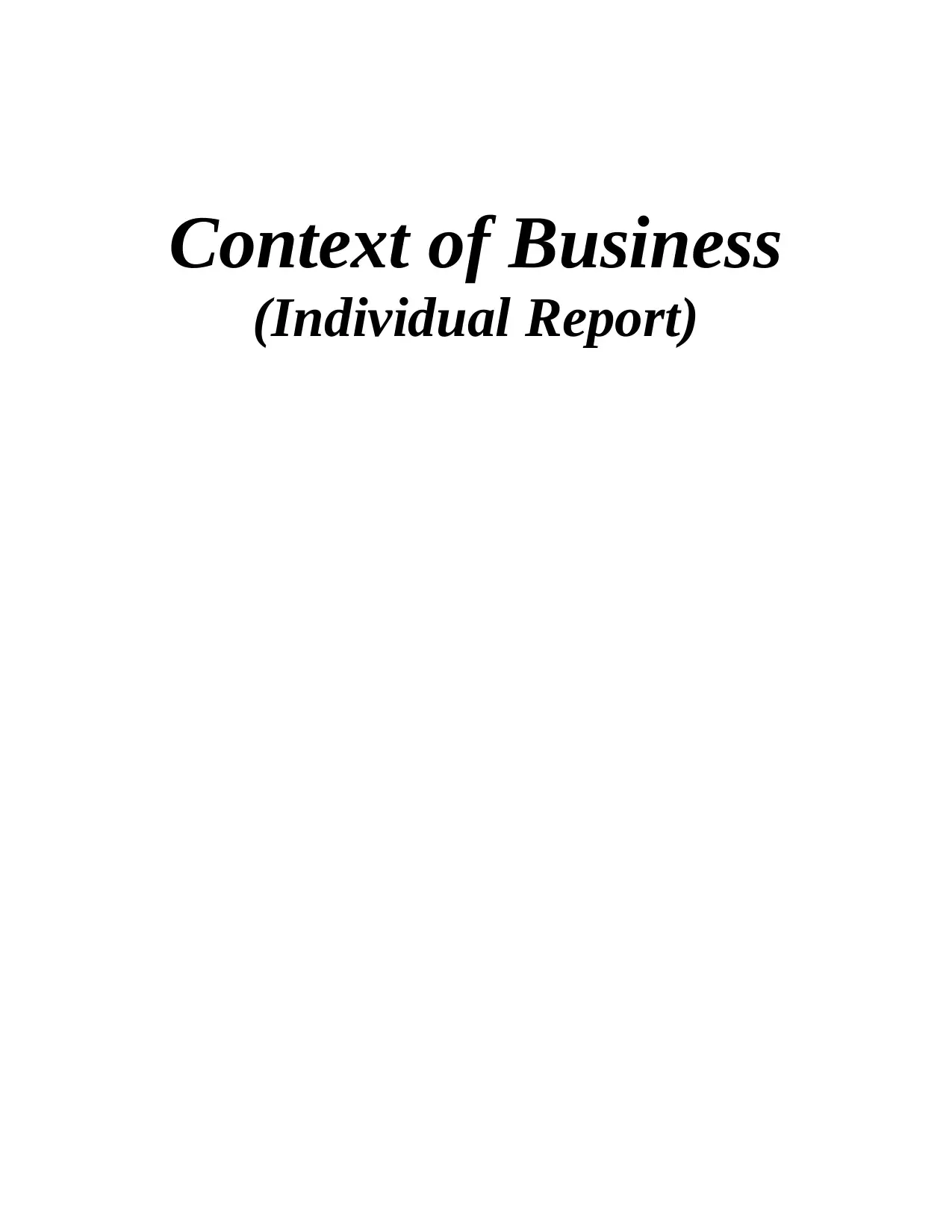
Context of Business
(Individual Report)
(Individual Report)
Paraphrase This Document
Need a fresh take? Get an instant paraphrase of this document with our AI Paraphraser
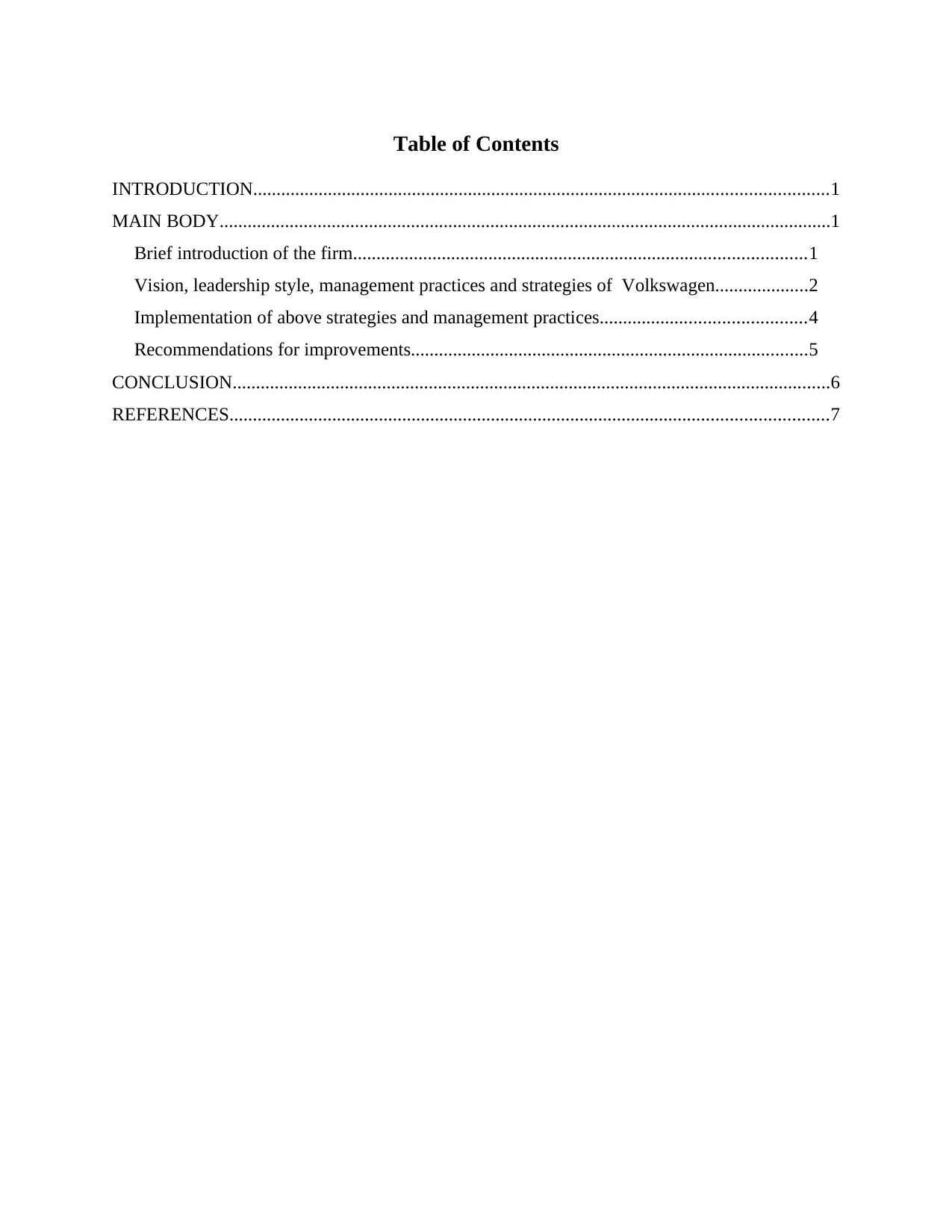
Table of Contents
INTRODUCTION...........................................................................................................................1
MAIN BODY...................................................................................................................................1
Brief introduction of the firm.................................................................................................1
Vision, leadership style, management practices and strategies of Volkswagen....................2
Implementation of above strategies and management practices............................................4
Recommendations for improvements.....................................................................................5
CONCLUSION................................................................................................................................6
REFERENCES................................................................................................................................7
INTRODUCTION...........................................................................................................................1
MAIN BODY...................................................................................................................................1
Brief introduction of the firm.................................................................................................1
Vision, leadership style, management practices and strategies of Volkswagen....................2
Implementation of above strategies and management practices............................................4
Recommendations for improvements.....................................................................................5
CONCLUSION................................................................................................................................6
REFERENCES................................................................................................................................7
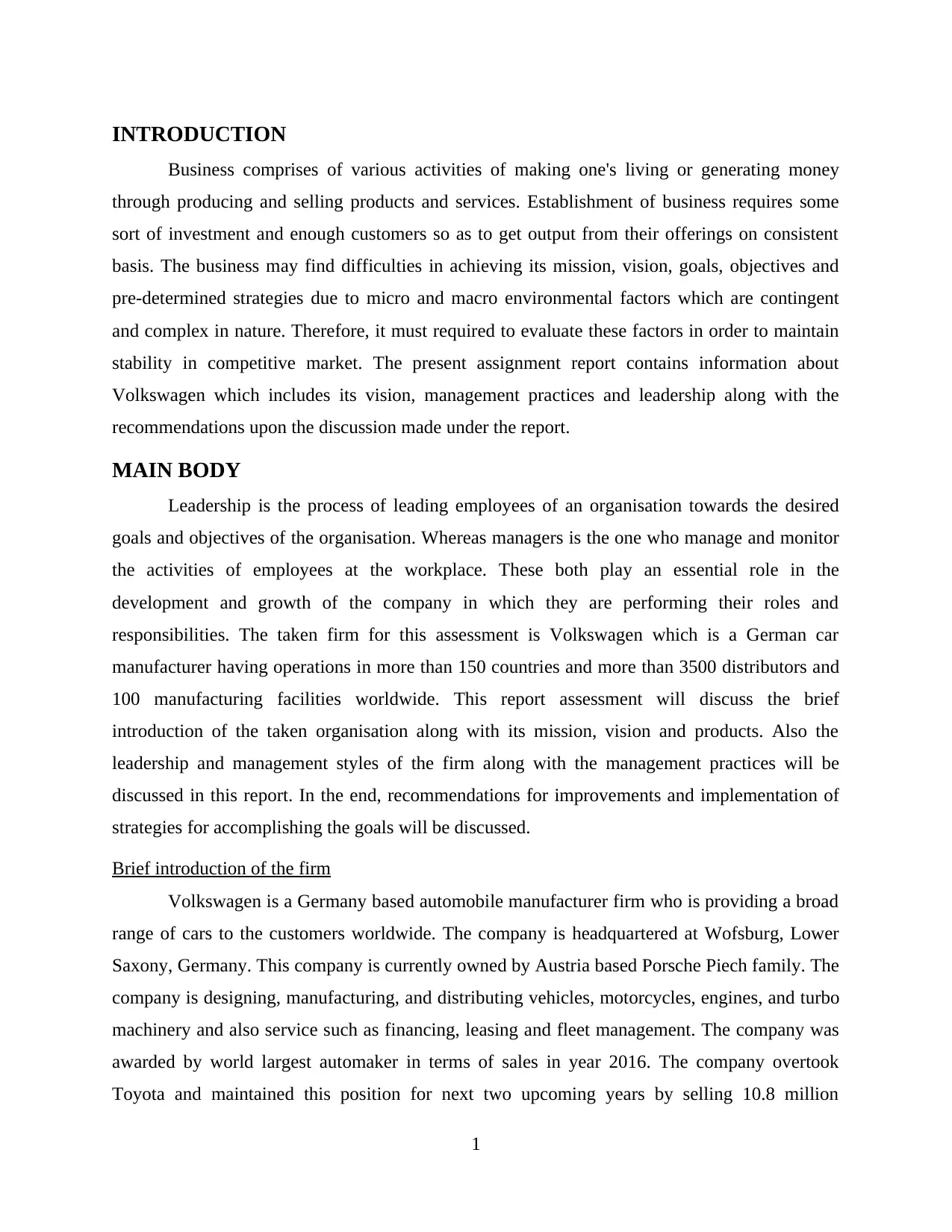
INTRODUCTION
Business comprises of various activities of making one's living or generating money
through producing and selling products and services. Establishment of business requires some
sort of investment and enough customers so as to get output from their offerings on consistent
basis. The business may find difficulties in achieving its mission, vision, goals, objectives and
pre-determined strategies due to micro and macro environmental factors which are contingent
and complex in nature. Therefore, it must required to evaluate these factors in order to maintain
stability in competitive market. The present assignment report contains information about
Volkswagen which includes its vision, management practices and leadership along with the
recommendations upon the discussion made under the report.
MAIN BODY
Leadership is the process of leading employees of an organisation towards the desired
goals and objectives of the organisation. Whereas managers is the one who manage and monitor
the activities of employees at the workplace. These both play an essential role in the
development and growth of the company in which they are performing their roles and
responsibilities. The taken firm for this assessment is Volkswagen which is a German car
manufacturer having operations in more than 150 countries and more than 3500 distributors and
100 manufacturing facilities worldwide. This report assessment will discuss the brief
introduction of the taken organisation along with its mission, vision and products. Also the
leadership and management styles of the firm along with the management practices will be
discussed in this report. In the end, recommendations for improvements and implementation of
strategies for accomplishing the goals will be discussed.
Brief introduction of the firm
Volkswagen is a Germany based automobile manufacturer firm who is providing a broad
range of cars to the customers worldwide. The company is headquartered at Wofsburg, Lower
Saxony, Germany. This company is currently owned by Austria based Porsche Piech family. The
company is designing, manufacturing, and distributing vehicles, motorcycles, engines, and turbo
machinery and also service such as financing, leasing and fleet management. The company was
awarded by world largest automaker in terms of sales in year 2016. The company overtook
Toyota and maintained this position for next two upcoming years by selling 10.8 million
1
Business comprises of various activities of making one's living or generating money
through producing and selling products and services. Establishment of business requires some
sort of investment and enough customers so as to get output from their offerings on consistent
basis. The business may find difficulties in achieving its mission, vision, goals, objectives and
pre-determined strategies due to micro and macro environmental factors which are contingent
and complex in nature. Therefore, it must required to evaluate these factors in order to maintain
stability in competitive market. The present assignment report contains information about
Volkswagen which includes its vision, management practices and leadership along with the
recommendations upon the discussion made under the report.
MAIN BODY
Leadership is the process of leading employees of an organisation towards the desired
goals and objectives of the organisation. Whereas managers is the one who manage and monitor
the activities of employees at the workplace. These both play an essential role in the
development and growth of the company in which they are performing their roles and
responsibilities. The taken firm for this assessment is Volkswagen which is a German car
manufacturer having operations in more than 150 countries and more than 3500 distributors and
100 manufacturing facilities worldwide. This report assessment will discuss the brief
introduction of the taken organisation along with its mission, vision and products. Also the
leadership and management styles of the firm along with the management practices will be
discussed in this report. In the end, recommendations for improvements and implementation of
strategies for accomplishing the goals will be discussed.
Brief introduction of the firm
Volkswagen is a Germany based automobile manufacturer firm who is providing a broad
range of cars to the customers worldwide. The company is headquartered at Wofsburg, Lower
Saxony, Germany. This company is currently owned by Austria based Porsche Piech family. The
company is designing, manufacturing, and distributing vehicles, motorcycles, engines, and turbo
machinery and also service such as financing, leasing and fleet management. The company was
awarded by world largest automaker in terms of sales in year 2016. The company overtook
Toyota and maintained this position for next two upcoming years by selling 10.8 million
1
⊘ This is a preview!⊘
Do you want full access?
Subscribe today to unlock all pages.

Trusted by 1+ million students worldwide
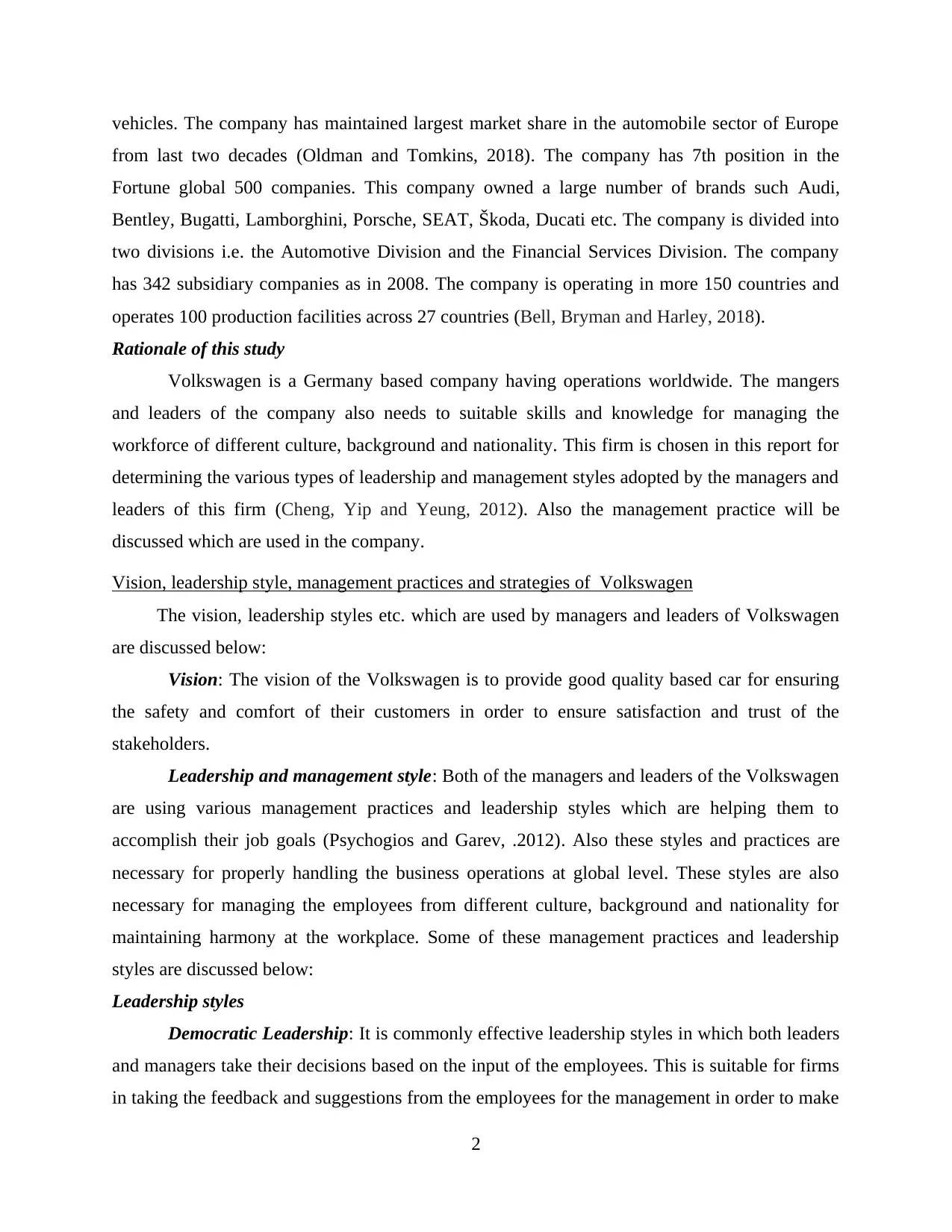
vehicles. The company has maintained largest market share in the automobile sector of Europe
from last two decades (Oldman and Tomkins, 2018). The company has 7th position in the
Fortune global 500 companies. This company owned a large number of brands such Audi,
Bentley, Bugatti, Lamborghini, Porsche, SEAT, Škoda, Ducati etc. The company is divided into
two divisions i.e. the Automotive Division and the Financial Services Division. The company
has 342 subsidiary companies as in 2008. The company is operating in more 150 countries and
operates 100 production facilities across 27 countries (Bell, Bryman and Harley, 2018).
Rationale of this study
Volkswagen is a Germany based company having operations worldwide. The mangers
and leaders of the company also needs to suitable skills and knowledge for managing the
workforce of different culture, background and nationality. This firm is chosen in this report for
determining the various types of leadership and management styles adopted by the managers and
leaders of this firm (Cheng, Yip and Yeung, 2012). Also the management practice will be
discussed which are used in the company.
Vision, leadership style, management practices and strategies of Volkswagen
The vision, leadership styles etc. which are used by managers and leaders of Volkswagen
are discussed below:
Vision: The vision of the Volkswagen is to provide good quality based car for ensuring
the safety and comfort of their customers in order to ensure satisfaction and trust of the
stakeholders.
Leadership and management style: Both of the managers and leaders of the Volkswagen
are using various management practices and leadership styles which are helping them to
accomplish their job goals (Psychogios and Garev, .2012). Also these styles and practices are
necessary for properly handling the business operations at global level. These styles are also
necessary for managing the employees from different culture, background and nationality for
maintaining harmony at the workplace. Some of these management practices and leadership
styles are discussed below:
Leadership styles
Democratic Leadership: It is commonly effective leadership styles in which both leaders
and managers take their decisions based on the input of the employees. This is suitable for firms
in taking the feedback and suggestions from the employees for the management in order to make
2
from last two decades (Oldman and Tomkins, 2018). The company has 7th position in the
Fortune global 500 companies. This company owned a large number of brands such Audi,
Bentley, Bugatti, Lamborghini, Porsche, SEAT, Škoda, Ducati etc. The company is divided into
two divisions i.e. the Automotive Division and the Financial Services Division. The company
has 342 subsidiary companies as in 2008. The company is operating in more 150 countries and
operates 100 production facilities across 27 countries (Bell, Bryman and Harley, 2018).
Rationale of this study
Volkswagen is a Germany based company having operations worldwide. The mangers
and leaders of the company also needs to suitable skills and knowledge for managing the
workforce of different culture, background and nationality. This firm is chosen in this report for
determining the various types of leadership and management styles adopted by the managers and
leaders of this firm (Cheng, Yip and Yeung, 2012). Also the management practice will be
discussed which are used in the company.
Vision, leadership style, management practices and strategies of Volkswagen
The vision, leadership styles etc. which are used by managers and leaders of Volkswagen
are discussed below:
Vision: The vision of the Volkswagen is to provide good quality based car for ensuring
the safety and comfort of their customers in order to ensure satisfaction and trust of the
stakeholders.
Leadership and management style: Both of the managers and leaders of the Volkswagen
are using various management practices and leadership styles which are helping them to
accomplish their job goals (Psychogios and Garev, .2012). Also these styles and practices are
necessary for properly handling the business operations at global level. These styles are also
necessary for managing the employees from different culture, background and nationality for
maintaining harmony at the workplace. Some of these management practices and leadership
styles are discussed below:
Leadership styles
Democratic Leadership: It is commonly effective leadership styles in which both leaders
and managers take their decisions based on the input of the employees. This is suitable for firms
in taking the feedback and suggestions from the employees for the management in order to make
2
Paraphrase This Document
Need a fresh take? Get an instant paraphrase of this document with our AI Paraphraser
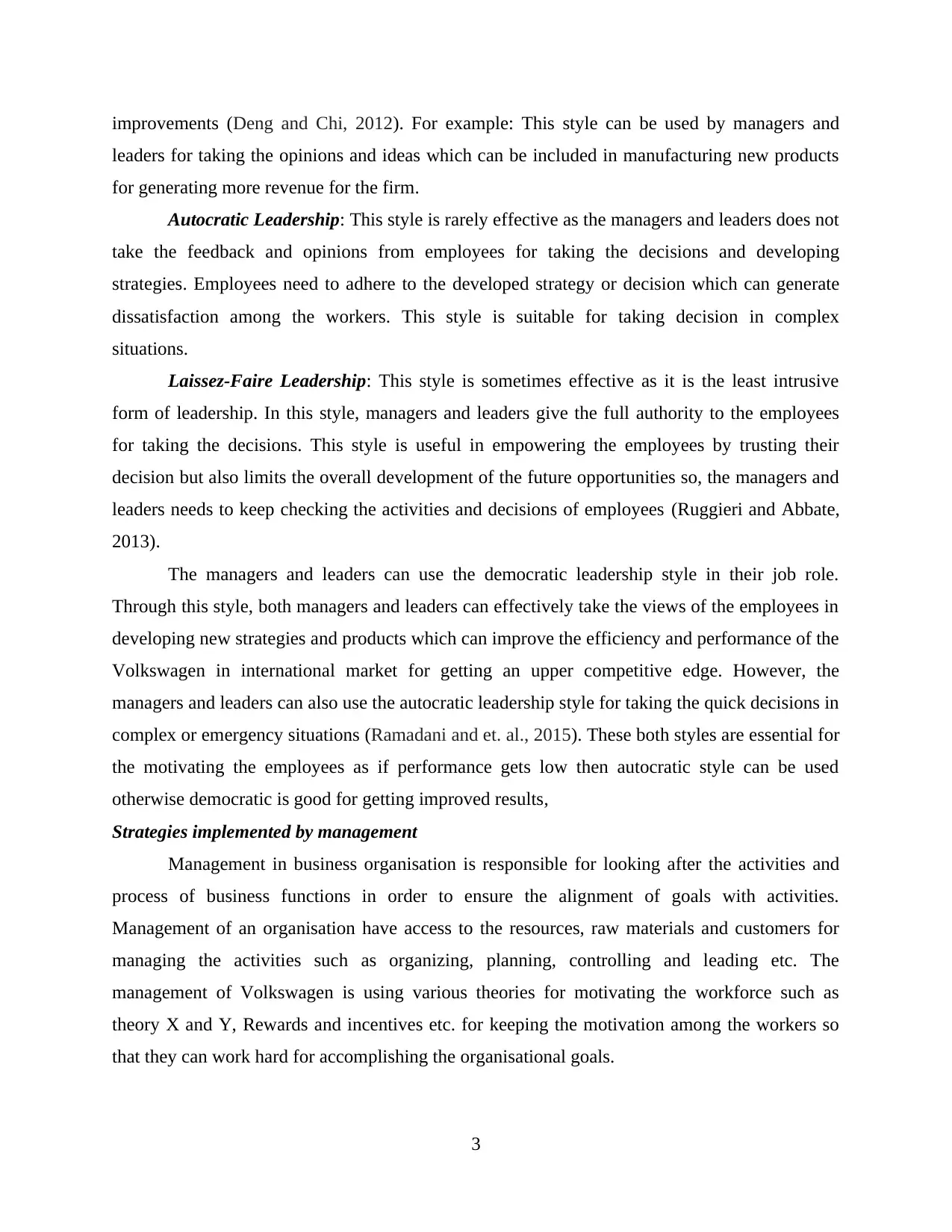
improvements (Deng and Chi, 2012). For example: This style can be used by managers and
leaders for taking the opinions and ideas which can be included in manufacturing new products
for generating more revenue for the firm.
Autocratic Leadership: This style is rarely effective as the managers and leaders does not
take the feedback and opinions from employees for taking the decisions and developing
strategies. Employees need to adhere to the developed strategy or decision which can generate
dissatisfaction among the workers. This style is suitable for taking decision in complex
situations.
Laissez-Faire Leadership: This style is sometimes effective as it is the least intrusive
form of leadership. In this style, managers and leaders give the full authority to the employees
for taking the decisions. This style is useful in empowering the employees by trusting their
decision but also limits the overall development of the future opportunities so, the managers and
leaders needs to keep checking the activities and decisions of employees (Ruggieri and Abbate,
2013).
The managers and leaders can use the democratic leadership style in their job role.
Through this style, both managers and leaders can effectively take the views of the employees in
developing new strategies and products which can improve the efficiency and performance of the
Volkswagen in international market for getting an upper competitive edge. However, the
managers and leaders can also use the autocratic leadership style for taking the quick decisions in
complex or emergency situations (Ramadani and et. al., 2015). These both styles are essential for
the motivating the employees as if performance gets low then autocratic style can be used
otherwise democratic is good for getting improved results,
Strategies implemented by management
Management in business organisation is responsible for looking after the activities and
process of business functions in order to ensure the alignment of goals with activities.
Management of an organisation have access to the resources, raw materials and customers for
managing the activities such as organizing, planning, controlling and leading etc. The
management of Volkswagen is using various theories for motivating the workforce such as
theory X and Y, Rewards and incentives etc. for keeping the motivation among the workers so
that they can work hard for accomplishing the organisational goals.
3
leaders for taking the opinions and ideas which can be included in manufacturing new products
for generating more revenue for the firm.
Autocratic Leadership: This style is rarely effective as the managers and leaders does not
take the feedback and opinions from employees for taking the decisions and developing
strategies. Employees need to adhere to the developed strategy or decision which can generate
dissatisfaction among the workers. This style is suitable for taking decision in complex
situations.
Laissez-Faire Leadership: This style is sometimes effective as it is the least intrusive
form of leadership. In this style, managers and leaders give the full authority to the employees
for taking the decisions. This style is useful in empowering the employees by trusting their
decision but also limits the overall development of the future opportunities so, the managers and
leaders needs to keep checking the activities and decisions of employees (Ruggieri and Abbate,
2013).
The managers and leaders can use the democratic leadership style in their job role.
Through this style, both managers and leaders can effectively take the views of the employees in
developing new strategies and products which can improve the efficiency and performance of the
Volkswagen in international market for getting an upper competitive edge. However, the
managers and leaders can also use the autocratic leadership style for taking the quick decisions in
complex or emergency situations (Ramadani and et. al., 2015). These both styles are essential for
the motivating the employees as if performance gets low then autocratic style can be used
otherwise democratic is good for getting improved results,
Strategies implemented by management
Management in business organisation is responsible for looking after the activities and
process of business functions in order to ensure the alignment of goals with activities.
Management of an organisation have access to the resources, raw materials and customers for
managing the activities such as organizing, planning, controlling and leading etc. The
management of Volkswagen is using various theories for motivating the workforce such as
theory X and Y, Rewards and incentives etc. for keeping the motivation among the workers so
that they can work hard for accomplishing the organisational goals.
3
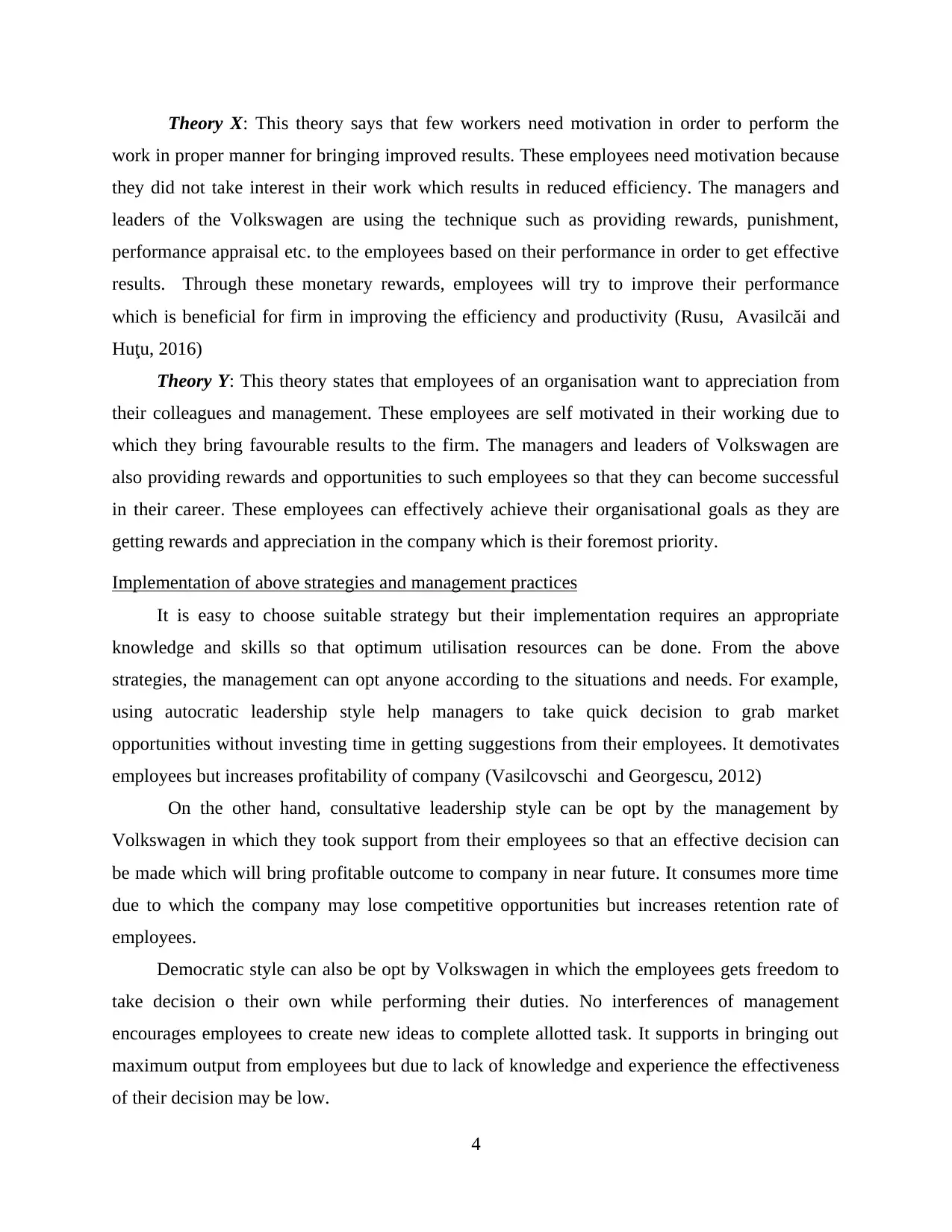
Theory X: This theory says that few workers need motivation in order to perform the
work in proper manner for bringing improved results. These employees need motivation because
they did not take interest in their work which results in reduced efficiency. The managers and
leaders of the Volkswagen are using the technique such as providing rewards, punishment,
performance appraisal etc. to the employees based on their performance in order to get effective
results. Through these monetary rewards, employees will try to improve their performance
which is beneficial for firm in improving the efficiency and productivity (Rusu, Avasilcăi and
Huţu, 2016)
Theory Y: This theory states that employees of an organisation want to appreciation from
their colleagues and management. These employees are self motivated in their working due to
which they bring favourable results to the firm. The managers and leaders of Volkswagen are
also providing rewards and opportunities to such employees so that they can become successful
in their career. These employees can effectively achieve their organisational goals as they are
getting rewards and appreciation in the company which is their foremost priority.
Implementation of above strategies and management practices
It is easy to choose suitable strategy but their implementation requires an appropriate
knowledge and skills so that optimum utilisation resources can be done. From the above
strategies, the management can opt anyone according to the situations and needs. For example,
using autocratic leadership style help managers to take quick decision to grab market
opportunities without investing time in getting suggestions from their employees. It demotivates
employees but increases profitability of company (Vasilcovschi and Georgescu, 2012)
On the other hand, consultative leadership style can be opt by the management by
Volkswagen in which they took support from their employees so that an effective decision can
be made which will bring profitable outcome to company in near future. It consumes more time
due to which the company may lose competitive opportunities but increases retention rate of
employees.
Democratic style can also be opt by Volkswagen in which the employees gets freedom to
take decision o their own while performing their duties. No interferences of management
encourages employees to create new ideas to complete allotted task. It supports in bringing out
maximum output from employees but due to lack of knowledge and experience the effectiveness
of their decision may be low.
4
work in proper manner for bringing improved results. These employees need motivation because
they did not take interest in their work which results in reduced efficiency. The managers and
leaders of the Volkswagen are using the technique such as providing rewards, punishment,
performance appraisal etc. to the employees based on their performance in order to get effective
results. Through these monetary rewards, employees will try to improve their performance
which is beneficial for firm in improving the efficiency and productivity (Rusu, Avasilcăi and
Huţu, 2016)
Theory Y: This theory states that employees of an organisation want to appreciation from
their colleagues and management. These employees are self motivated in their working due to
which they bring favourable results to the firm. The managers and leaders of Volkswagen are
also providing rewards and opportunities to such employees so that they can become successful
in their career. These employees can effectively achieve their organisational goals as they are
getting rewards and appreciation in the company which is their foremost priority.
Implementation of above strategies and management practices
It is easy to choose suitable strategy but their implementation requires an appropriate
knowledge and skills so that optimum utilisation resources can be done. From the above
strategies, the management can opt anyone according to the situations and needs. For example,
using autocratic leadership style help managers to take quick decision to grab market
opportunities without investing time in getting suggestions from their employees. It demotivates
employees but increases profitability of company (Vasilcovschi and Georgescu, 2012)
On the other hand, consultative leadership style can be opt by the management by
Volkswagen in which they took support from their employees so that an effective decision can
be made which will bring profitable outcome to company in near future. It consumes more time
due to which the company may lose competitive opportunities but increases retention rate of
employees.
Democratic style can also be opt by Volkswagen in which the employees gets freedom to
take decision o their own while performing their duties. No interferences of management
encourages employees to create new ideas to complete allotted task. It supports in bringing out
maximum output from employees but due to lack of knowledge and experience the effectiveness
of their decision may be low.
4
⊘ This is a preview!⊘
Do you want full access?
Subscribe today to unlock all pages.

Trusted by 1+ million students worldwide
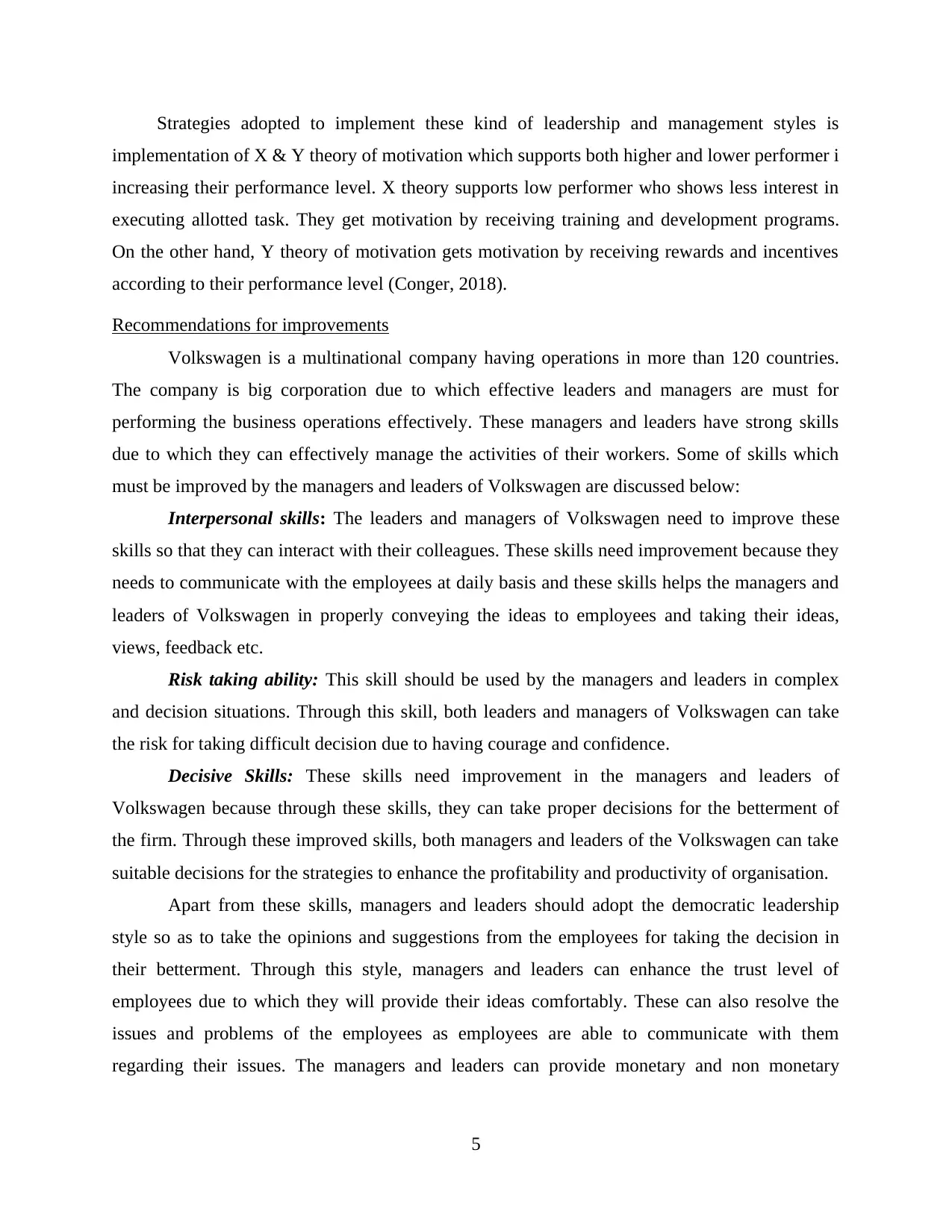
Strategies adopted to implement these kind of leadership and management styles is
implementation of X & Y theory of motivation which supports both higher and lower performer i
increasing their performance level. X theory supports low performer who shows less interest in
executing allotted task. They get motivation by receiving training and development programs.
On the other hand, Y theory of motivation gets motivation by receiving rewards and incentives
according to their performance level (Conger, 2018).
Recommendations for improvements
Volkswagen is a multinational company having operations in more than 120 countries.
The company is big corporation due to which effective leaders and managers are must for
performing the business operations effectively. These managers and leaders have strong skills
due to which they can effectively manage the activities of their workers. Some of skills which
must be improved by the managers and leaders of Volkswagen are discussed below:
Interpersonal skills: The leaders and managers of Volkswagen need to improve these
skills so that they can interact with their colleagues. These skills need improvement because they
needs to communicate with the employees at daily basis and these skills helps the managers and
leaders of Volkswagen in properly conveying the ideas to employees and taking their ideas,
views, feedback etc.
Risk taking ability: This skill should be used by the managers and leaders in complex
and decision situations. Through this skill, both leaders and managers of Volkswagen can take
the risk for taking difficult decision due to having courage and confidence.
Decisive Skills: These skills need improvement in the managers and leaders of
Volkswagen because through these skills, they can take proper decisions for the betterment of
the firm. Through these improved skills, both managers and leaders of the Volkswagen can take
suitable decisions for the strategies to enhance the profitability and productivity of organisation.
Apart from these skills, managers and leaders should adopt the democratic leadership
style so as to take the opinions and suggestions from the employees for taking the decision in
their betterment. Through this style, managers and leaders can enhance the trust level of
employees due to which they will provide their ideas comfortably. These can also resolve the
issues and problems of the employees as employees are able to communicate with them
regarding their issues. The managers and leaders can provide monetary and non monetary
5
implementation of X & Y theory of motivation which supports both higher and lower performer i
increasing their performance level. X theory supports low performer who shows less interest in
executing allotted task. They get motivation by receiving training and development programs.
On the other hand, Y theory of motivation gets motivation by receiving rewards and incentives
according to their performance level (Conger, 2018).
Recommendations for improvements
Volkswagen is a multinational company having operations in more than 120 countries.
The company is big corporation due to which effective leaders and managers are must for
performing the business operations effectively. These managers and leaders have strong skills
due to which they can effectively manage the activities of their workers. Some of skills which
must be improved by the managers and leaders of Volkswagen are discussed below:
Interpersonal skills: The leaders and managers of Volkswagen need to improve these
skills so that they can interact with their colleagues. These skills need improvement because they
needs to communicate with the employees at daily basis and these skills helps the managers and
leaders of Volkswagen in properly conveying the ideas to employees and taking their ideas,
views, feedback etc.
Risk taking ability: This skill should be used by the managers and leaders in complex
and decision situations. Through this skill, both leaders and managers of Volkswagen can take
the risk for taking difficult decision due to having courage and confidence.
Decisive Skills: These skills need improvement in the managers and leaders of
Volkswagen because through these skills, they can take proper decisions for the betterment of
the firm. Through these improved skills, both managers and leaders of the Volkswagen can take
suitable decisions for the strategies to enhance the profitability and productivity of organisation.
Apart from these skills, managers and leaders should adopt the democratic leadership
style so as to take the opinions and suggestions from the employees for taking the decision in
their betterment. Through this style, managers and leaders can enhance the trust level of
employees due to which they will provide their ideas comfortably. These can also resolve the
issues and problems of the employees as employees are able to communicate with them
regarding their issues. The managers and leaders can provide monetary and non monetary
5
Paraphrase This Document
Need a fresh take? Get an instant paraphrase of this document with our AI Paraphraser
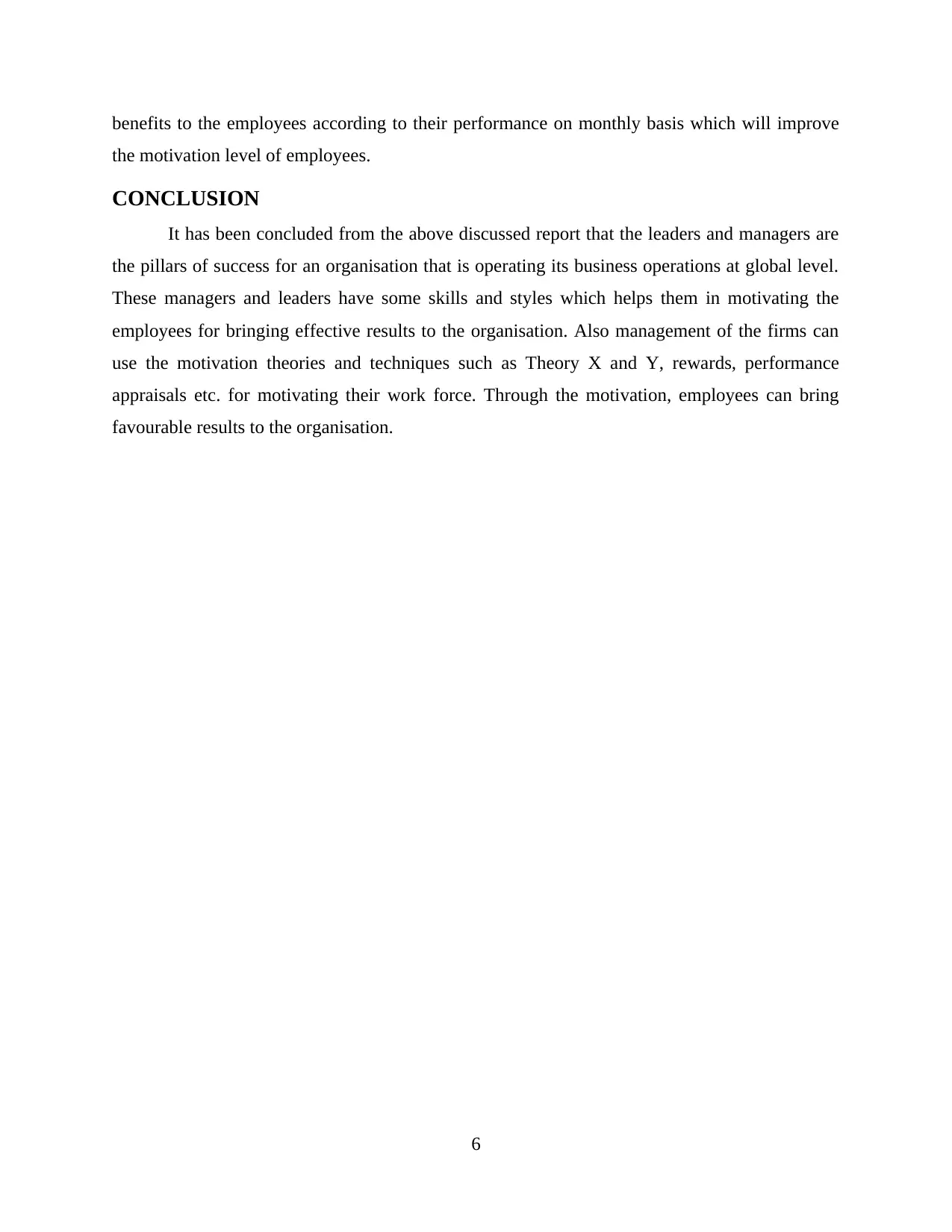
benefits to the employees according to their performance on monthly basis which will improve
the motivation level of employees.
CONCLUSION
It has been concluded from the above discussed report that the leaders and managers are
the pillars of success for an organisation that is operating its business operations at global level.
These managers and leaders have some skills and styles which helps them in motivating the
employees for bringing effective results to the organisation. Also management of the firms can
use the motivation theories and techniques such as Theory X and Y, rewards, performance
appraisals etc. for motivating their work force. Through the motivation, employees can bring
favourable results to the organisation.
6
the motivation level of employees.
CONCLUSION
It has been concluded from the above discussed report that the leaders and managers are
the pillars of success for an organisation that is operating its business operations at global level.
These managers and leaders have some skills and styles which helps them in motivating the
employees for bringing effective results to the organisation. Also management of the firms can
use the motivation theories and techniques such as Theory X and Y, rewards, performance
appraisals etc. for motivating their work force. Through the motivation, employees can bring
favourable results to the organisation.
6
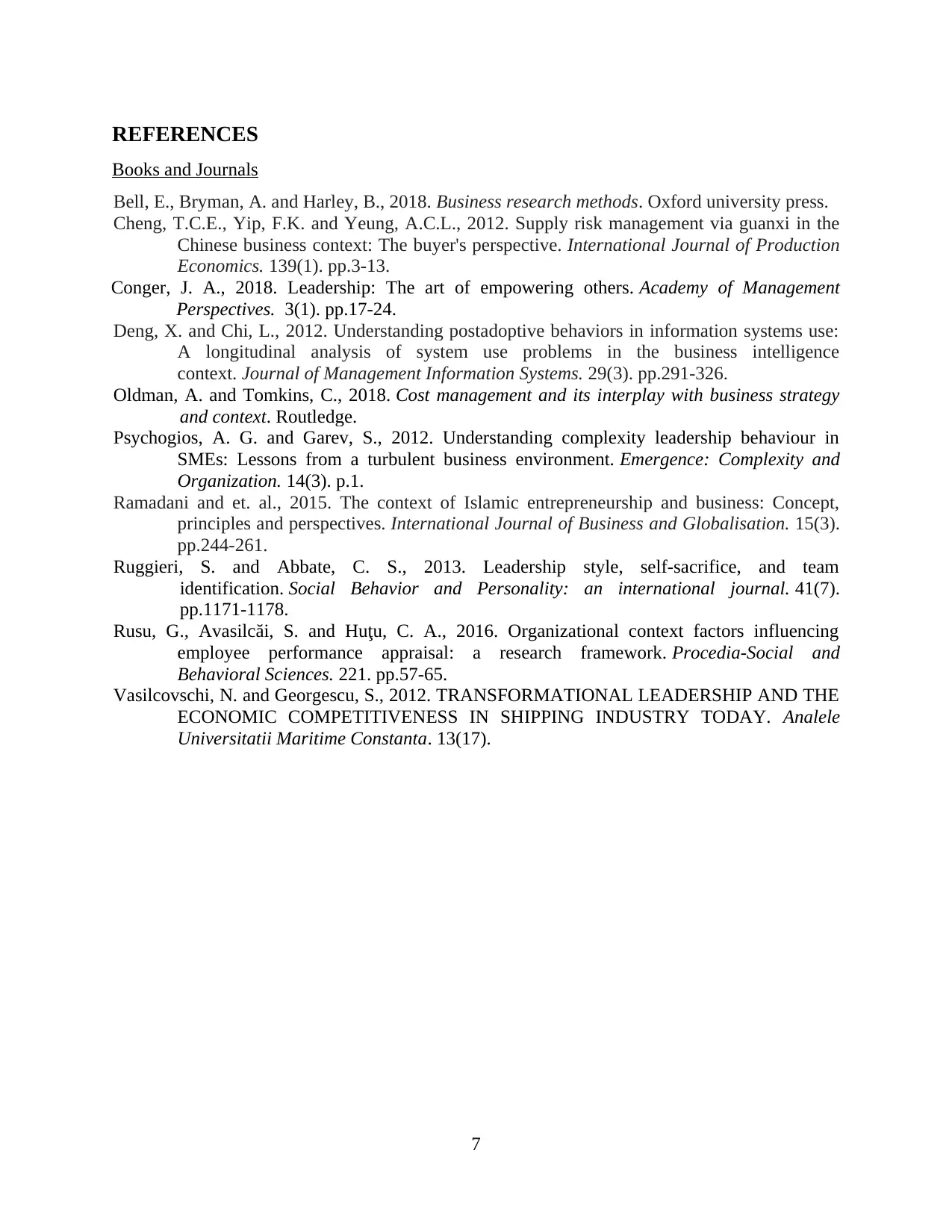
REFERENCES
Books and Journals
Bell, E., Bryman, A. and Harley, B., 2018. Business research methods. Oxford university press.
Cheng, T.C.E., Yip, F.K. and Yeung, A.C.L., 2012. Supply risk management via guanxi in the
Chinese business context: The buyer's perspective. International Journal of Production
Economics. 139(1). pp.3-13.
Conger, J. A., 2018. Leadership: The art of empowering others. Academy of Management
Perspectives. 3(1). pp.17-24.
Deng, X. and Chi, L., 2012. Understanding postadoptive behaviors in information systems use:
A longitudinal analysis of system use problems in the business intelligence
context. Journal of Management Information Systems. 29(3). pp.291-326.
Oldman, A. and Tomkins, C., 2018. Cost management and its interplay with business strategy
and context. Routledge.
Psychogios, A. G. and Garev, S., 2012. Understanding complexity leadership behaviour in
SMEs: Lessons from a turbulent business environment. Emergence: Complexity and
Organization. 14(3). p.1.
Ramadani and et. al., 2015. The context of Islamic entrepreneurship and business: Concept,
principles and perspectives. International Journal of Business and Globalisation. 15(3).
pp.244-261.
Ruggieri, S. and Abbate, C. S., 2013. Leadership style, self-sacrifice, and team
identification. Social Behavior and Personality: an international journal. 41(7).
pp.1171-1178.
Rusu, G., Avasilcăi, S. and Huţu, C. A., 2016. Organizational context factors influencing
employee performance appraisal: a research framework. Procedia-Social and
Behavioral Sciences. 221. pp.57-65.
Vasilcovschi, N. and Georgescu, S., 2012. TRANSFORMATIONAL LEADERSHIP AND THE
ECONOMIC COMPETITIVENESS IN SHIPPING INDUSTRY TODAY. Analele
Universitatii Maritime Constanta. 13(17).
7
Books and Journals
Bell, E., Bryman, A. and Harley, B., 2018. Business research methods. Oxford university press.
Cheng, T.C.E., Yip, F.K. and Yeung, A.C.L., 2012. Supply risk management via guanxi in the
Chinese business context: The buyer's perspective. International Journal of Production
Economics. 139(1). pp.3-13.
Conger, J. A., 2018. Leadership: The art of empowering others. Academy of Management
Perspectives. 3(1). pp.17-24.
Deng, X. and Chi, L., 2012. Understanding postadoptive behaviors in information systems use:
A longitudinal analysis of system use problems in the business intelligence
context. Journal of Management Information Systems. 29(3). pp.291-326.
Oldman, A. and Tomkins, C., 2018. Cost management and its interplay with business strategy
and context. Routledge.
Psychogios, A. G. and Garev, S., 2012. Understanding complexity leadership behaviour in
SMEs: Lessons from a turbulent business environment. Emergence: Complexity and
Organization. 14(3). p.1.
Ramadani and et. al., 2015. The context of Islamic entrepreneurship and business: Concept,
principles and perspectives. International Journal of Business and Globalisation. 15(3).
pp.244-261.
Ruggieri, S. and Abbate, C. S., 2013. Leadership style, self-sacrifice, and team
identification. Social Behavior and Personality: an international journal. 41(7).
pp.1171-1178.
Rusu, G., Avasilcăi, S. and Huţu, C. A., 2016. Organizational context factors influencing
employee performance appraisal: a research framework. Procedia-Social and
Behavioral Sciences. 221. pp.57-65.
Vasilcovschi, N. and Georgescu, S., 2012. TRANSFORMATIONAL LEADERSHIP AND THE
ECONOMIC COMPETITIVENESS IN SHIPPING INDUSTRY TODAY. Analele
Universitatii Maritime Constanta. 13(17).
7
⊘ This is a preview!⊘
Do you want full access?
Subscribe today to unlock all pages.

Trusted by 1+ million students worldwide
1 out of 9
Related Documents
Your All-in-One AI-Powered Toolkit for Academic Success.
+13062052269
info@desklib.com
Available 24*7 on WhatsApp / Email
![[object Object]](/_next/static/media/star-bottom.7253800d.svg)
Unlock your academic potential
Copyright © 2020–2025 A2Z Services. All Rights Reserved. Developed and managed by ZUCOL.




